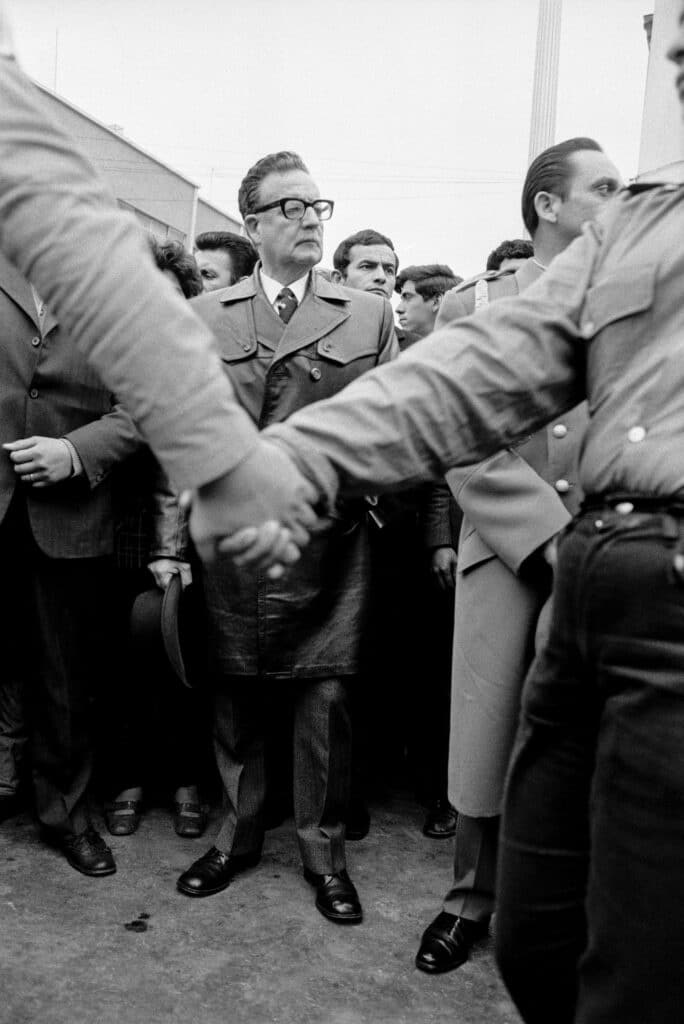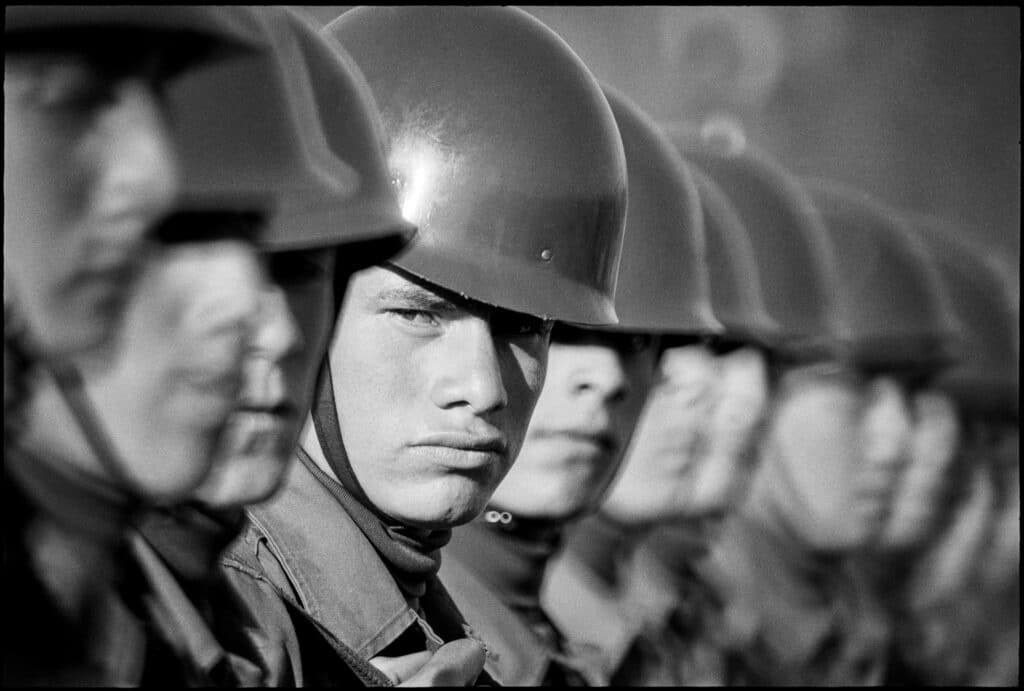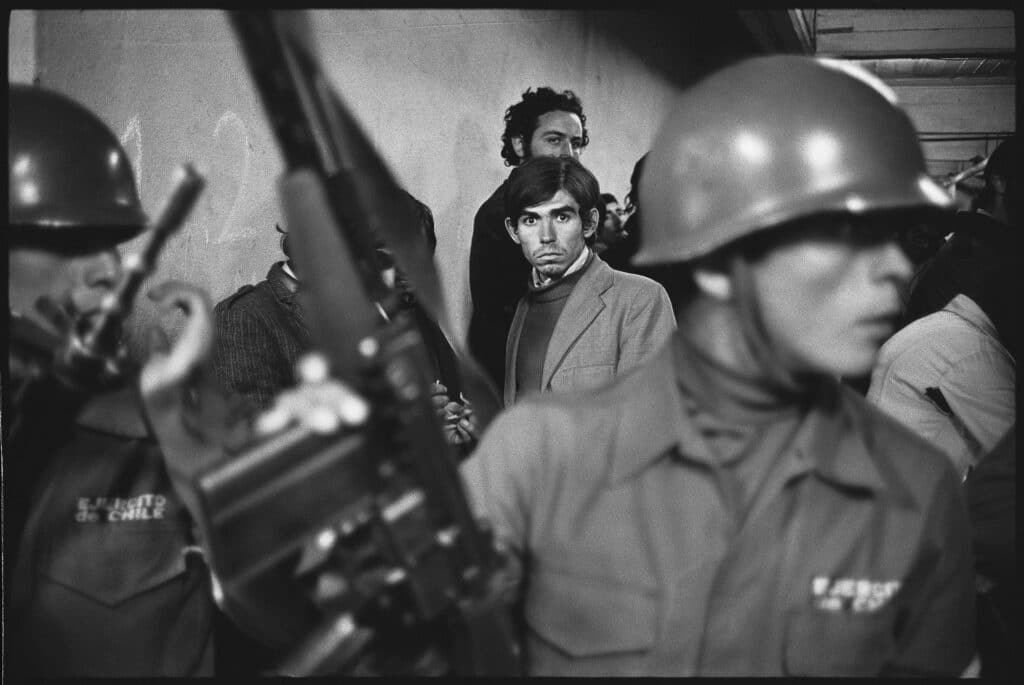Raymond Depardon arrived slightly late at a restaurant in central Toulouse, where David Burnett was already waiting. The two photographers greeted each other with a warm hug. They hadn’t seen each other in years. They owed this reunion to Chile: “Sharing an exhibition and a book publication with Raymond is an honor; there are few individuals whom I hold, personally and professionally, in such esteem,” said Burnett with admiration. “My friendship with David is also nurtured by our shared language—having an American photographer who speaks French is quite special!” Depardon chimes in jokingly.
Christian Caujolles, the artistic director of Toulouse’s Château d’Eau Gallery, strategically planned for the exhibition Raymond Depardon–David Burnett, September 1971/1973 in Chile to open on September 11, 2023. This date marks the 50th anniversary of the coup d’état that toppled the Allende government and ushered in Pinochet’s dictatorship. The five decades that followed these events resonate throughout the exhibition and the accompanying book, Septembre au Chili, 1971/1973, published by Editions EXB.
A taciturn photographer with big, astonished eyes
“Captured at average shutter speeds of 1/250 and /125, respectively, Depardon’s and Burnett’s 117 images on display constitute only a small slice of the actual timeline,” notes Robert “Bob” Pledge, the co-founder of Contact Press Image agency and the key catalyst behind this dual testimony on Chile.
It was Pledge, then editorial secretary of Zoom magazine, who persuaded his friend Depardon to come to Chile with him in September 1971. They were to witness the commemoration of the first anniversary of Popular Unity and Salvador Allende’s ascendancy to power in 1970. The pair were already battle-tested companions. Just months prior, in January 1970, they found themselves alongside Gilles Caron and Michel Honorin in Chad. Captured in an ambush, they were held prisoner and released a month later. This experience solidified their friendship.
Depardon said yes to the Chilean adventure, but his aim was to explore the heart of the “longest country in the world.” He traveled south, in the footsteps of Nobel Prize winning poet Pablo Neruda. Next, he visited the lands of the Mapuche people, where he encountered landscapes and communities evocative of Ireland and the Massif Central. Luis Poirot, the official photographer for Salvador Allende’s presidential campaign in 1970, described Depardon as “a taciturn photographer with big, astonished eyes.” With the empathetic, observant gaze of a farmer’s son, Depardon captured moments of seed-sowing, cow-milking, and pastoral life.
“I’d always felt ashamed of being a peasant’s son; now, that feeling was turned on its head.”
Raymond Depardon
For the then 30-year-old Depardon, the expedition was revelatory. “It was a shock,” he recalled at the dinner table in the Toulouse restaurant. “For the first time, I was photographing farmers, and discovered I had the knack for it. I’d always felt ashamed of being a peasant’s son; now, that feeling was turned on its head.” The world of peasants transcends geographical boundaries. In the distinctive faces of these Chileans marginalized by an urban society, Depardon recognized the soul of his own childhood, anchored in Villefranche-sur-Saône and his family’s farm at Le Garet.
Alongside Pledge, Depardon also delved into Santiago’s bustling social scene and even secured a meeting with President Allende, a figurehead of democratic socialism. “We didn’t have an appointment; we were just incredibly lucky,” he acknowledges. In an international bookstore in the heart of the Chilean capital, Pledge stumbled upon an issue of L’Express featuring a cover photo of Georges Pompidou taken by Depardon. The idea was to suggest posing President Allende in a portrait similar to that of his French counterpart. After several days of negotiations, the meeting finally took place October 5, 1971, at the official residence in Tomas Moro.

Depardon and Pledge exceeded their initial half-hour time slot, spending two full hours with President Allende. “He posed effortlessly, his dogs at his side. He was eager to embody the Chilean people. Allende was optimistic about his nation’s future and hoped his leadership would spark change across South America. Sadly, we know what transpired later,” reflects Depardon.
The last image of Salvador Allende alive, stepping out from his palace at La Moneda, gun in hand, is displayed in large format in the exhibition. Captured by Leopoldo Victor Vargas, the only military photographer permanently assigned to the presidential palace of La Moneda, the photograph took on added meaning after Allende took his own life just hours later, using that very shotgun. The photo, which miraculously found its way to the New York Times newsroom, ended up on the front page, but no one knew who had taken it.
“This was certainly the most frightening moment of my stay in Chile”
David Burnett takes the relay and continues the story. Fresh off a two-year stint in Vietnam, where he reported for Time and Life magazines, Burnett headed to Chile in September 1973. Now associated with Gamma New York—headed by Robert Pledge, with whom he would later co-found Contact Press Images—Burnett arrived in the country ten days after the military junta seized control.
He still vividly recalls the unsettling ambiance of a virtually isolated Santiago as he stepped out of a Boeing 707 packed with journalists: “Several of us, unfamiliar with the city, initially helped unload the luggage from the plane—the airport was still closed—before entering the capital on a dump truck. Soldiers and police were everywhere, their faces devoid of warmth or welcome. The gravity of the situation was palpable,” he elaborates looking at his photos on display.

The volatile situation demanded extreme caution. “Whenever I got a compelling shot, I’d quickly pocket the film and rush back to the hotel to stash it safely in my room,” Burnett says. Streets were deserted, machine guns stood poised at intersections, patrols checked passersby, and soldiers burned ideologically “suspect” books.
On September 21, 1973, Burnett captured an image that epitomized the ruling dictatorship. General Augusto Ramon Pinochet Ugarte, the army’s commander-in-chief, emerged from his first press conference. Wearing a military cap and sunglasses, he gazed through his car window directly at a camera trained on his face. “At first, I wasn’t too happy that the camera was in the frame, but later it came to symbolize the standoff between the junta and the global press,” reflects Burnett, who would go on to witness the regime’s brutal crackdown later that same day.
“We were ordered to stay quiet and not to move. The sounds of people being tortured and beaten filled the air—sounds that I will never forget,”
David Burnett
Joined by his roommate and fellow photographer, Bob Sherman, from Miami, Burnett found himself outside Santiago’s stadium, which had been converted into a detention center for political dissidents. “My Spanish was rudimentary, so I asked a soldier if we could go inside and take some photos. He directed us to an entrance,” Burnett recounts.
Barely inside the gate, their cameras were confiscated, and they were pushed against a wall. “We were ordered to stay quiet and not to move. The sounds of people being tortured and beaten filled the air—sounds that I will never forget,” recalls Burnett. After a tense two-hour detainment, they were released alogn with their cameras. “It was certainly the most frightening moment of my stay in Chile. Ironically, an ‘official’ stadium tour for international press was organized the very next day, on September 22, 1973. The new government wanted to showcase its ‘humane’ treatment of prisoners.”
As journalists tried in vain to gather testimonies by shouting their questions to the prisoners seated in the bleachers behind fences, the tour was cut short. Yet Burnett was determined to explore the part where he’d heard the screams the day before: “I kept insisting, ‘I want to go there; I need to see it!’” The soldiers hesitated. Just then, a new group of prisoners were escorted in. Seizing the moment, Burnett raised his Leica and aimed it at the penetrating gaze of one of the new arrivals. He managed to snap several frames before the journalists were rushed to the exit. The photo—depicting a young man with wide, haunting eyes—would later gain notoriety. Identified three decades later, the man was Daniel Cespedes.

Three days later, Burnett covered the funeral of Pablo Neruda, who had died two days prior. “If not for the presence of the international press, there would have been no funeral,” Burnett notes. His photographs capture a heart-wrenching procession, which many viewed as the first significant act of resistance against Pinochet’s regime. “It was incredibly moving,” says Burnett. In Santiago’s general cemetery, his lens focused on crosses all bearing the same date, “September 18, 1973”—stark evidence of a brutal regime that would last until 1990.
“David’s unyielding memory has become a part of our collective conscience,” says photographer Luis Poirot. “He captured these moments for us—for Chilean photographers unable to bear witness to our own history.” These invaluable testimonies by two great photographers chronicle Chile’s transformation—from a nation hopeful for a fairer, more democratic future, to one torn apart by a dictatorship that was responsible for over 3,200 deaths and “disappearances,” around 38,000 instances of torture, and the exile of several hundred thousand people.
Exhibition: Raymond Depardon—David Burnett, Septembre au Chili,1971/1973, until January 7, Galerie du Château d’Eau, Toulouse.
Book: Septembre au Chili 1971–1973, Raymond Depardon, David Burnett, Atelier EXB, 192 pp., €49



